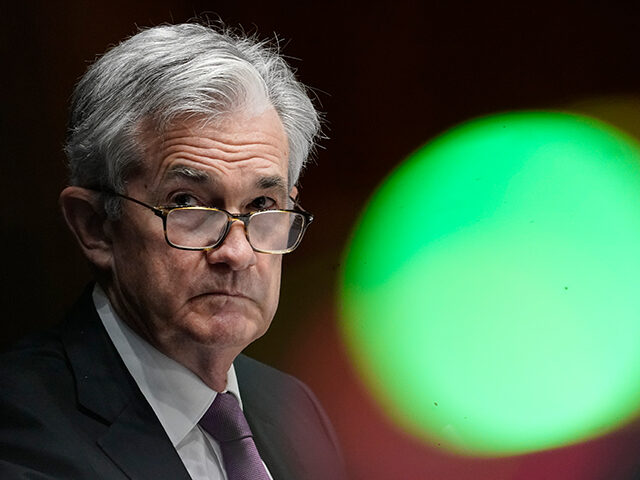This Is What It Sounds Like When Hawks Cry
You have to wonder if Jerome Powell is a bit frustrated with the unbridled enthusiasm of the stock market this week.
The Federal Reserve chairman gave hawkish keynote address at the Jackson Hole conference on Friday—and the markets have basically construed it and the economic data released ever since in the most dovish possible way.
In the Jackson Hole address, Powell’s clearest message was that the Fed would keep rates more or less steady for now. Twice he said the Fed would “proceed carefully” in any further move, an indication that the Fed felt little urgency to raise rates.
“Given how far we have come, at coming meetings we are in a position to proceed carefully,” Powell said, noting that Fed officials would “decide whether to tighten further or, instead, to hold the policy rate constant and await further data.”
Notice that Powell was describing the Fed’s policy choices ahead in binary terms: tighten further or hold the policy rate constant. There was no hint of rate cuts on the horizon.
Powell also pointed out that the economy had not slowed as much as officials expected.
It is worth quoting Powell at length here:
Restrictive monetary policy has tightened financial conditions, supporting the expectation of below-trend growth. Since last year’s symposium, the two-year real yield is up about 250 basis points, and longer-term real yields are higher as well—by nearly 150 basis points. Beyond changes in interest rates, bank lending standards have tightened, and loan growth has slowed sharply. Such a tightening of broad financial conditions typically contributes to a slowing in the growth of economic activity, and there is evidence of that in this cycle as well. For example, growth in industrial production has slowed, and the amount spent on residential investment has declined in each of the past five quarters.
But we are attentive to signs that the economy may not be cooling as expected. So far this year, GDP (gross domestic product) growth has come in above expectations and above its longer-run trend, and recent readings on consumer spending have been especially robust. In addition, after decelerating sharply over the past 18 months, the housing sector is showing signs of picking back up. Additional evidence of persistently above-trend growth could put further progress on inflation at risk and could warrant further tightening of monetary policy.
In other words, higher rates have made borrowing more expensive, but economic growth has been accelerating this year. The housing sector is bouncing back. If this keeps happening, the Fed may very well have to get back into the rate-hiking business.
Flying Away on a Wing and Prayer
A heightened risk of further rate hikes would ordinarily be a negative for stock prices. But stocks rallied on Friday, Monday, Tuesday, and Wednesday. The S&P 500 has moved above its 50-day moving average, generally considered a sign of bullish investor sentiment.
This has been a “bad news is good news” rally. On Tuesday, we got a weaker-than-expected estimate of job openings in the Job Openings and Labor Turnover Survey (JOLTS). The number of quits fell, which can be a sign that workers feel less confident that there are more jobs out there. The ratio of job vacancies to unemployed persons fell to 1.5 from 1.6 percent in prior data. The Conference Board’s index of consumer sentiment declined more than expected, with the share of consumers saying labor market conditions are “bad” jumping a full percentage point to 17.2 percent.

Traders work on the floor of the New York Stock Exchange during morning trading on August 25, 2023, in New York City. (Michael M. Santiago/Getty Images)
It’s not so much that investors hate confident consumers and employed workers, but they do understand that the Fed has frequently cited the tightness of the labor market as a key inflation risk.
Back in January of 2022, Powell said:
We see a labor market where, by so many measures, it is historically tight. … If you look at things like quits and job openings, as I mentioned earlier, and wages, you’re seeing — and, and just the ratio of job openings to unemployed — you’re seeing a very, very tight labor market.
It is also a “good news is no news” rally. Investors have also been able to overlook “evidence of persistently above-trend growth” from the housing market. The Case-Shiller Home Price indices showed home prices are on the rise. The FHFA’s home price index is up 3.1 percent year-over-year. Pending home sales rose for a second straight month in July, the National Association of Realtors said Tuesday.
Powell specifically called out the rebound of the housing sector as a reason for caution that growth could continue to come in above expectations — but no one seems to care.
As of Wednesday, the fed funds futures market was indicating an 80 percent chance that the Fed will cut rates at least once by the June 2024 meeting. There’s nearly a 50 percent implied chance of more than one cut.
Powell said the Fed was watching data to decide whether to hike or hold. The market is convinced cuts are coming. “Don’t fight the Fed” is one of the oldest and most ignored maxims of Wall Street.

COMMENTS
Please let us know if you're having issues with commenting.